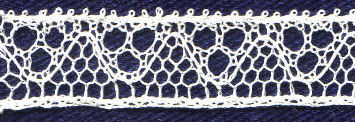
Small Bucks point triangles. See pattern 13.


Small Bucks point triangles. See pattern 13.
There is a common Bucks Point shape which lies alongside a picots and passives headside. It looks like a triangle, but has rounded corners. It is made of honeycomb surrounded by gimps. I suggest that you understand all these before trying triangles.
The photo above shows a small triangle, while the diagrams below show bigger ones. A description of a bigger triangle will help you understand the principle behind them, I hope, so you can adapt the description for different shapes and sizes.

triangle pattern
The diagram below avoids the complexities of the individual stitches by showing each pair of threads as a single line. Where one line crosses another inside the triangle, you should work it as half stitch and twist, pin, half stitch and twist (or honeycomb). The gimp is shown in red. Click here to see how to work a gimp. Outside the gimp is not part of the triangle, and so will be worked in whatever stitch is required - perhaps a headside or ground. This is marked in green.
|
|
Working: First work all lace above the triangle, down to and including the top gimp. This is marked in green, as it is outside the gimps.
Now work across in diagonal rows. Inside the red gimp is honeycomb. The rows are different. For one row, one pair works across all others, and for the next, there are couples of pairs worked together. My patterns mark where the threads go which should help! You need also to consider the start and end of each row. On the left, a pair crosses the gimp, does a bit of picots and passives headside, then returns back across the gimp. On the left, a pair crosses the gimp to enter the rest of the lace. You will have to work some lace outside the gimp to get a pair to cross the gimp again, to re-enter the triangle of honeycomb. Do not forget that the stitch inside the gimps is honeycomb, while outside it is probably something different. Don't get them muddled up!
After a bit, you start to meet the bottom of the triangle. This is not obviously in the diagrams, as I had to leave out the pattern to make the threads clearer. But the gimp path will be marked on the pattern, so it will be obvious. So now, the right-hand pair crosses the gimp, but does not need to do any other lace stitches, as no more lace pairs need to re-enter this triangle.
The left gimp may also need to work across a pair right at the bottom - it depends on the shape. It does in this triangle.
Once the two gimps are next to each other, they cross over. Lace will need to be worked before the next triangle, and then pairs cross the gimps to start the next triangle.
© Jo Edkins 2016 - return to lace index